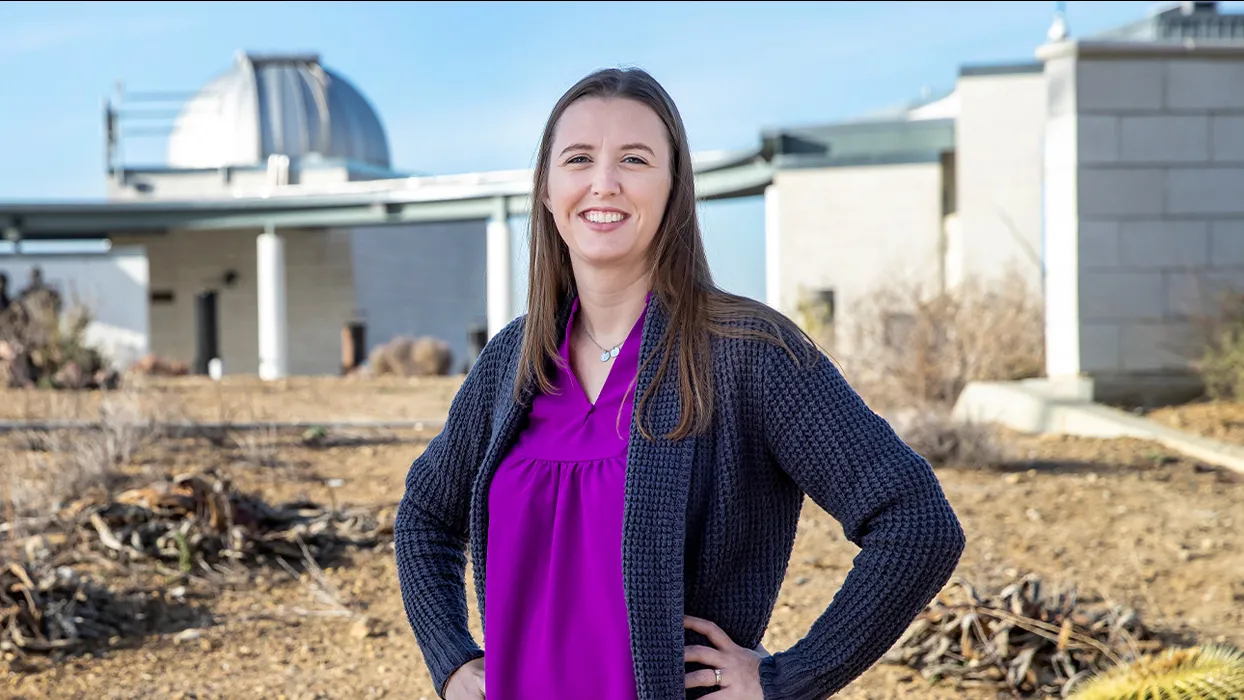Alan Llavore | Office of Marketing and Communications | (909) 537-5007 | allavore@csusb.edu

This past spring, California State University, San Bernardino’s Murillo Family Observatory held a First Light event to celebrate the successful installation of a new and a repaired telescope in its domes on March 19. Former long-time director Carol Hood was proud of this latest expansion of the observatory’s tools to serve students and the public, as well as the science of astronomy and astrophysics at CSUSB. This time, however, her perspective was from her then-role as interim associate dean in the College of Natural Sciences (CNS).
Hood has since been appointed the permanent CNS associate dean after a nationwide search. CNS Dean Sastry Pantula said, “She has demonstrated exemplary leadership and dedication to advancing the mission and goals of CNS” during her time holding down the interim position.
He praised both her expertise and experience. “We are excited to have her officially step into the role of associate dean and are confident that her expertise and leadership will continue to elevate CNS to new heights of excellence.”
When Hood joined CSUSB in 2012, the observatory was just opening. Over the years leading up to her new administrative appointment, the biggest change she has seen with the introduction of the observatory was the way it has allowed the department — formerly just called “physics” but now physics and astronomy — to expand the curriculum available to students. Her hire ensured there were two astronomers on the faculty; a third was hired in 2020. With the recent addition of a fourth hire, 50 percent of the department’s faculty are now astronomers.
Changing the department’s name has brought it more in line with the times. During the university’s conversion from a quarter to a semester system, the department created an astronomy minor. It was very popular: when classes were offered, they were full. The observatory allowed the classes to provide a much larger observation component, due to the on-site telescopes. The existence of a capstone project for minors, for example, allows students to use the larger telescope for more ambitious projects.
Hood points out that an advantage of CSUSB’s set of telescopes, and the way she has trained students to follow and study her particular objects, is these same skill sets allow students to undertake a variety of projects. One of the most precious observatory resources is having dedicated time and access to telescopes. Because the telescopes are CSUSB’s, the university does not have to compete with other organizations or institutions to use them.
“This ownership allows us to study objects over time,” she said, which is the focus of her own research. “Time monitoring is easy to do, but few places have telescopes dedicated to that. I look forward to getting our students more involved in this aspect of astronomy.”
She stepped back from the directorship a year ago to take on her role as part of the college’s leadership team. Assistant professor Matteo Crismani serves as the new director.
Hood’s wishes for the future include securing grants to widen access to the observatory for the general public, along with supporting the recovery from the pandemic. For example, COVID-19 disrupted the observatory’s monthly public open houses. Funding issues, both at CSUSB and in local public schools, have cut back on K-12 outreach opportunities. A future dream also includes creating a lab space up at the observatory itself.
Her other wish, once the department can regularly offer the necessary classes, would be to turn the minor into something more like a major, even if not a major itself. She envisions a degree in physics with a concentration in astronomy. Or something more like an astrophysics degree. Hood points out there is a huge overlap between the skillsets used in physics and astronomy.
While the telescope in the smaller dome was being repaired, students had the opportunity to take an older telescope donated by a nonprofit and make it robotic. Through the engineering skills they acquired, the students were able to obtain outstanding jobs post-graduation. Hood is incredibly proud of both the ability to provide this opportunity for CSUSB students and for how positively it has impacted their futures.
The thing she misses most in her current administrative role is not seeing students on a day-to-day basis. The other is scheduling time to continue her own research. That would involve staying up at the observatory until midnight or 1 a.m. In the past, she would schedule those observation times for days when she was not required to be on campus early the next morning. Her calendar these days is not as flexible.
Nevertheless, she looks forward to continuing to support the observatory from her new role in college administration, whether in terms of the infrastructure, funding or whatever opportunities may arise. The observatory is an important resource for CNS, the university as a whole and for our surrounding communities.
Hood has her bachelor of science degree in physics from Virginia Tech and her master of science degree and doctorate degree in physics from the University of California, Irvine.
For more information about the observatory, visit the Murillo Family Observatory website.
For more information about the Department of Physics and Astronomy, visit the Department of Physics and Astronomy website.
For more information about the College of Natural Sciences, visit the CNS website.